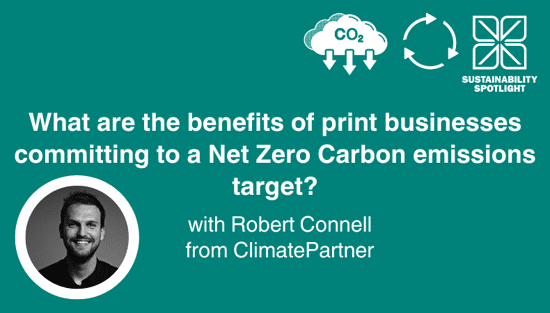What is the connection between the printing business and the Sustainable Development Goals (SDGs)?

Regina Wilhelm, Sustainability and Environmental Management lead at Brother At Your Side reiterates the importance for print businesses to follow the United Nations Sustainable Development Goals.
Let’s talk sustainability – But why?
Sustainability, is a so-called buzzword of our time: everybody talks about it – but does everyone know what it is exactly? The term sustainability does not have an official definition, which may be one reason for its inflationary use these days. Nonetheless, it is worth exploring the term. The concept of sustainability explores the relationship between economic development, environmental quality, and social equity.
This concept has been evolving since 1972 when the international community first explored the connection between quality of life and environmental quality at the United Nations Conference of the Human Environment in Stockholm. In 1987, the term „sustainable development“ reached the discussion and is defined as „development that meets the needs of the present generation without compromising the ability of future generations to meet their own needs“ (Brundtland G.H., 1987). From then on, a focus was put on the balance of economic and social needs of the people in connection with the regenerative capacity of the natural environment.
An honest, but maybe drastic statement is: most of our current economic practices have rather devastating consequences for the natural fundamentals of life. By saying this, it also meant that our current lifestyles undermine the prosperity of future generations. All contrary to the above-mentioned aims of sustainable development. Some examples of this evolution are the large-scale deforestation, overfishing of the oceans, and the loss of fertile arable land which all show that we are far away from a balance between the three elements of social and economic needs of people and the regenerative capacity of the environment. This is even worse given the fact that the consequential costs of climate change and the loss of biodiversity alone could amount to around a quarter of the world's gross national product by 2050 (Umwelt Bundesamt, 2023).
This imbalance becomes even more apparent when looking at the concept of the “Earth Overshoot Day” which is determined for each year by the think tank Global Footprint Network. The Earth Overshoot Day marks the date when humanity has exhausted “nature’s budget” for the year1. Humanity’s ecological footprint and the earth’s biocapacity have deviated to the degree that our planet’s resources now only last us until late July. This means that humanity is exhausting nature’s renewable resources in just over half a year, leaving us in an ecological deficit for the rest of the year. Consequently, the human lifestyle requires natural resources of 1.75 worlds instead of the available one.
Consequentially, it should become clear that a "business as usual" approach, in which the industrialized countries maintain their resource-intensive economies and the developing and emerging countries adopt these economies, is not a viable path. Therefore, a transition towards sustainability which acts within ecological guard rails and preserves natural capital is needed. Sustainable practices should positively combine ecology and economy and thereby increase social welfare. The overall goal is an economy that is in harmony with the social and environmental elements.
Understandably, this may sound too altruistic for the business community, BUT: behind all this is not only the desire to do something good, but rather to ensure one's own continued existence - and efforts towards tangible economic interests, such as ensuring the quality of life and thus location, or simply the favor of customers. Consequently, this also means that environmental protection and economic development are not opposites, they are mutually dependent. Hence, we should act according to the motto „pay now, benefit later“ or „plan for tomorrow, so that you are still existing the day after tomorrow“. The reasoning behind all this is that it will be extremely difficult and/ or expensive to meet increased sustainability demands by governments, customers, or other stakeholders when starting late. Of course, the overall “living on tick” has emerged from our capitalist system – which is faulty but the best system we have at hand.
To name an example in the business sector of how businesses can make it better by engaging in authentic sustainability efforts is the outdoor brand Patagonia. Although it is a profit-orientated entity, it is engaged in environmental protection through e.g., its Earth Tax, whereby it gives away 1% of its revenues to ecological projects already since 1985; its newly created Home Planet Fund which should act as the "activistic arm" of Patagonia; their concentration on the use of recycled fibers and ecological cotton as one of the first in their industry since the mid-nineties – today 85% of Patagonia’s synthetic fibers are recycled and thereby the company states that no new fossil oil will be used in their products until 2025. To prolong the life cycle of their products, Patagonia established the biggest repair service in North America and opened another one in Amsterdam. With the same reasoning, the brand engages in the re-buying and selling of its products on a secondhand platform.
While other companies are promising climate neutrality through CO2 compensation utilizing reforestation projects, Patagonia aims to engage in emission reduction within its own business operations. In that regard, Patagonia lays the focus on their material production which accounts for more than 87% of their greenhouse gas (GHG) emissions.
Another crucial aspect of the path toward more sustainability is transparency. Patagonia takes a transparent and honest approach: the company previously planned to reach climate neutrality in 2025 but had to postpone this target to 2040. Although this can be considered a step back, their actions can be backed by real effort as stated above as well as transparent reactions by admitting that with their firstly set target, they have aimed too high in the beginning.
After reading this, one might wonder how this company is performing economically. The company has a turnover of 1.5 billion US dollars and employs around 3,300 people. While other outdoor companies are stumbling or growing much more slowly, Patagonia seems to be immune to economic crises. Patagonia is an environmentally conscious brand for outerwear products, not only for its use of recycled fabrics but also due to the different programs it has implemented to lower its environmental impact.
Hence, as a business entity, Patagonia makes a real effort and combines its engagement with the core business instead of buying itself out through e.g., reforestation projects. The market proves them correct: Patagonia is one of the strongest outdoor brands these days and has already been for some time. It's a different, responsible way of setting an example for companies to become aware of their responsibility in a capitalist system.
After setting the stage with a successful sustainability story, let us move towards the printing industry and an important sustainability framework, the Agenda 2030, and its Sustainable Development Goals.
The Sustainable Development Goals – a compass for sustainable action in the printing business?
One way to arrange one’s activities to become more sustainable is to consider the Sustainable Development Goals (SDGs). In 2015, the international community decided on The Agenda 2030 and its Sustainable Development Goals (SDGs) – which are a blueprint for people, planet, and prosperity by 2030, as well as a symbol of the aims seized by people around the world for a better future. Generally, the 17 goals can be described as an urgent call for action by all countries – developed and developing – in a global partnership. They recognize that ending poverty and other deprivations must go together with strategies that improve health and education, decrease inequality, and stimulate economic growth – all whilst fighting climate change and engaging in the preservation of our oceans and forests. The principal behind this agenda of interconnected goals is founded on the understanding that real sustainability can only be realized when economic, social as well as environmental concerns are treated as equally important and when all major actors, namely governments, civil society, the business sector as well as the public are represented in that process.
Having stated this, let’s zoom in on how the SDGs can be connected to the printing business. To do so, this blog will concentrate on SDG 12 on Responsible Consumption and Production and its sub-targets as this SDG is one and if not the most crucial SDG for the business community. It is recognized that fundamental changes in the way societies produce and consume are central to achieving global sustainable development.
SDG 12: Responsible consumption and production
The subject of responsible consumption and production has gained increased importance in our everyday life. In today's globalized world, people are buying various consumer goods which have been produced partly or completely in different countries of the world. Along with the importance of economic progress and prosperity, the consumption of different consumer goods serves human needs for food, housing, mobility, and entertainment, and allows us to lead an individualized lifestyle. Thus, consumption and production have allowed societies and economies to flourish. However, our prevailing consumption and production patterns entail an immense use of energy and natural resources and have actual long-term effects on people and the environment. Therefore, resource efficiency and sustainability should be the normative practice for the economic production side as well as the consumer lifestyle. To make our production and consumption patterns more responsible, life cycle thinking must be followed. Products need to be considered from “cradle to grave” whereby responsibility for each phase of the product’s life cycle such as resource extraction, production, distribution, use, waste disposal, and reuse must be (better) considered.
SDG 12 consists of further 11 targets and 13 indicators which have been mostly developed for the country government context but can also be applied to business practice. The table below lists sub-targets and indicators that can also be applied in the context of the printing industry.
Table 1: SDG 12: Selected sub-targets and indicators
|
Sub Targets |
Indicators |
|
Target 12.1: Implement the 10-year sustainable consumption and production framework |
Sustainable consumption and production action plans (e.g., short-, mid- and long-term goals) |
|
Target 12.2: Sustainable management and use of natural resources |
Material footprint; amount of material consumption (e.g., during manufacturing, but also in use of packaging material) |
|
Target 12.4: Responsible management of chemicals and waste |
Hazardous waste generation (e.g., in the context of inks and other liquids) |
|
Target 12.5: Substantially reduce waste generation |
Recycling rates (e.g., during manufacturing process, but also applicable to many other phases) |
|
Target 12.6: Encourage companies to adopt sustainable practices and sustainability reporting |
Companies publishing sustainability reports (thereby meeting e.g., GRI or CSRD requirements and revealing sustainability data in a transparent way and refraining from greenwashing) |
|
Target 12.7: Promote sustainable procurement practices |
Sustainable procurement plans at company level (relates to a more responsible value chain) |
|
Target 12.8: Promote understanding of sustainable lifestyles |
Extent of awareness of sustainable lifestyles (e.g., through employee training) |
|
Target 12.A: Support developing countries' scientific and technological capacity for sustainable consumption and production |
amount of support to developing countries on research and development for sustainable consumption and production and environmentally sound technologies |
Source: SDG Tracker (https://sdg-tracker.org/sustainable-consumption-production)
One sub-target is particularly fitting to the printing business and therefore, let us zoom in to sub-target 12.4 of responsible management of chemicals and waste. Against this background, it must be stated that some traditional printing methods use harsh chemicals, such as bleach and formaldehyde, which can be harmful to the environment and those working with them. Given the global water challenges, most importantly water scarcity and pollution, the printing business can be considered to have a potentially considerable impact on the overall global water availability and quality. Particularly traditional printing methods have immense water usage as well as a high effluent discharge in the printing process. Chemicals in wastewater can affect the local ecosystem or the people who use the water for fishing, washing or even drinking. In this context, it is also worth mentioning that the textile and clothing industry is responsible for around 20 percent of global industrial water consumption, and this is also where the printing industry is connected to.
In that respect, the connection to further SDGs can be briefly mentioned, namely to SDG 6 on Water and Sanitation and partly to SDG 14 on Life below Water. This connection can be particularly stressed as some traditional textile printing methods often involve the use of chemicals that can be harmful to the quality of water as well as marine life when they enter the water supply. A more detailed overview of sub-targets and indicators for these two goals can be found here and here. Because these harsh chemicals could reach rivers or other water sources if not disposed of correctly, they may even harm plants and animals and potentially enter the food chain as well as harm the operator if not handled with care. Having said this, these impacts can also be related to SDG 3 on Good Health and Well-being.
In comparison to such potential impacts of the printing business on the environment, a more sustainable printing method is represented by digital textile printing. Unlike traditional printing methods, digital textile printing doesn't require excessive amounts of water to e.g., clean screens and other equipment. Additionally, digital textile printing uses water-based inks that are free of harsh harmful chemicals, making it a safer and more environmentally friendly option. Thus, when putting the focus on chemicals and waste as in sub-target 12.4, digital textile printing is a more sustainable option compared to traditional printing methods. By adopting more sustainable printing methods, the printing industry can contribute to SDG 12 as well as help reduce the environmental impact of the textile industry.
Importantly, a different point of view on SDGs and their connection to the private sector, in general, should be recognized. The framework of the SDGs has been considered thoughtfully by the world community and stands for current and significant matters. In other words, these 17 goals have been selected by reason. This brings us to a sometimes-neglected fact: besides businesses’ impact on the environment, the environment can also influence businesses. This is the so-called inside-out and outside-in relation. With the continuance of climate change, environmental impacts are expected to become more encompassing, and companies will need to adapt and become resilient toward environmental risks.
In this regard, let us explore the topic of water a little further. One might ask: What is in for the business sector when considering one’s own relation to water, e.g., water consumption and pollution? The answer is that there are water-related risks that may influence the business sector – for instance, water scarcity and a possible threshold on water usage as well as the increased probability of flooding due to climate change. Obviously, these risks can be considered to have a great impact on industrial production – amongst other things. By use of this example, it is intended to demonstrate that environmental protection and economic interests are not necessarily counterparts. Rather, an environmentally conscious behavior supports the environmental contexts in which one's own continued existence will be ensured. One way to find a compass for such action is the Agenda 2030 and its SDGs. Hence, the SDGs are not only a call for action but also represent instruments for action towards more sustainability from which the business sector itself will benefit after all.
Topics
Recent news

What are the benefits of print businesses committing to a Net Zero Carbon emissions target?
We speak to Robert Connell, Senior Commercial Sustainability Manager at ClimatePartner who who offer solutions along the net zero cycle to support business’s effort in corporate climate action. In this discussion we discuss the importance and the process and benefits of businesses committing to a Net Zero Carbon emissions target.

6 Sustainable Printing Practices Changing the Game in Textile and Apparel Decoration
The textile industry is shifting towards sustainability. Innovations like waterless and digital printing, eco-friendly inks, and recycled materials are reducing waste. AI and automation optimise production, while circular models promote reuse. Consumer demand for transparency drives this change, making sustainable practices essential for future-focused brands.

Sustainability in Production Print: Advancing Practices in Wide Format, Textiles, and Software
As sustainability continues to take centerstage across industries, the production print sector is making massive strides in integrating eco-conscious practices. From wide format to textile applications, with the growing reliance on advanced production software, the space is evolving to meet environmental goals as well as consumer demand for sustainable products.

Why must the print industry recognise software and material innovation
Laurel Brunner argues that the printing industry must recognise the value of both software and material innovation, and be willing to pay for it. Software, though intangible, drives efficiency and reduces carbon footprints. While materials science currently dominates, R&D costs are inherent in all advancements. Paying a premium ensures continued progress, benefiting the industry's evolution and sustainability.